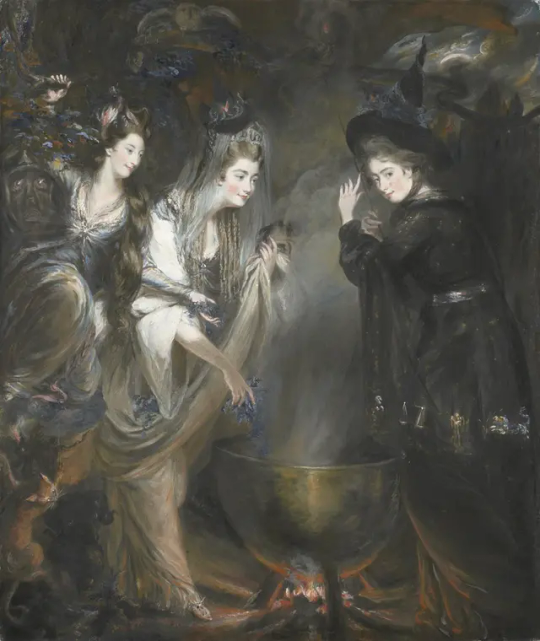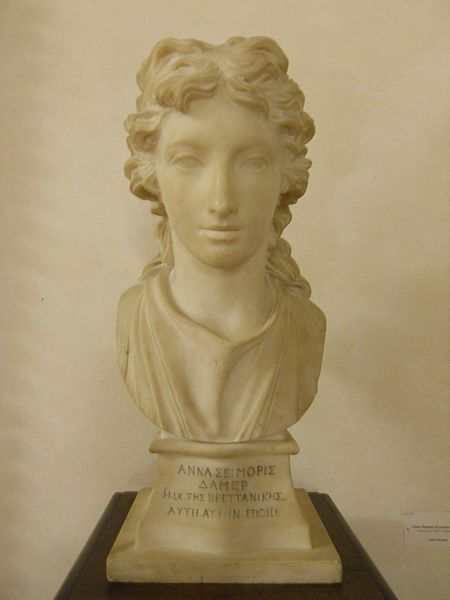#anne seymour damer
Text

Anne Seymour Damer (1748-1828)
"Shock Dog (nickname for a dog of the Maltese breed)" (c. 1782)
Marble
Located in the Metropolitan Museum of Art, New York City, New York, United States
Damer was celebrated as Britain’s first woman sculptor who portrayed both animals and people with a memorable personal style. Being of noble birth and highly educated, along with being an accomplished sculptor, she was also an author, traveler, theatrical producer, and actress.
At her death, Damer asked to be buried with her sculptor’s tools and the bones of her favorite dog.
In eighteenth-century Britain, small breeds like the Maltese were known as a shock dog for its rough coat, and were viewed as beloved companions.
#sculptures#art#artwork#animal sculpture#dogs#anne seymour damer#marble#fine art#metropolitan museum of art#the met#art gallery#english artist#british artist#woman artist#women artists#female artists#history#animals#fur#1780s#late 1700s#late 18th century
116 notes
·
View notes
Text
The English disapproval of Mrs Damer's conduct came at a time when lesbianism was identified with foreign influences and with bohemian and artistic behaviour. Marie Antoinette, Queen of France, was named for 'sapphic orgies', the slur combining – in one inclusive accusation – anti-Gallicism, anti-women and anti-monarchy.
"Normal Women: 900 Years of Making History" - Philippa Gregory
#book quote#normal women#philippa gregory#nonfiction#english#disapproval#anne seymour damer#lesbian#foreign influence#bohemian#artistic#marie antoinette#france#sappic orgies#gallicism#women#monarchy
2 notes
·
View notes
Text

Daniel Gardner (c.1750-1805) - The Three Witches from Macbeth, 1775
portraits of Elizabeth Lamb, Viscountess Melbourne; Georgiana, Duchess of Devonshire; Anne Seymour Damer
#daniel gardner#the three witches from macbeth#william shakespere#macbeth#“the scottish play”#witch#witches#witchcraft#portraits#art#gothic romanticism#painting
159 notes
·
View notes
Photo

Mrs Freeman as Isis
Anne Seymour Damer (1748–1828)
Victoria and Albert Museum
60 notes
·
View notes
Note
Hey, I've been listening for a few years now and love the podcast!
I'd like to suggest Anne Seymour Damer as a possible topic for an episode if possible!
Thanks!
I love getting suggestions we haven't had before, and I love finding links between queer people in history! Thank you!
-Alice
8 notes
·
View notes
Text

Anne Seymour Damer, née Conway, (1748 - 1828) was an English sculptor. Once described as a 'female genius' by Horace Walpole, she was trained in sculpture by Giuseppe Ceracchi and John Bacon. Influenced by the Enlightenment movement, Anne was an author, traveller, theatrical producer and actress, as well as an acclaimed sculptress.
A number of sources have named Damer as being involved in lesbian relationships, particularly relating to her close friendship with Mary Berry, to whom she had been introduced by Walpole in 1789, and with whom she lived together in her later years.
7 notes
·
View notes
Photo

Anne Seymour Damer (deceased)
Gender: Female
Sexuality: Lesbian
DOB: 8 November 1748
RIP: 28 May 1828
Ethnicity: White - English
Occupation: Sculptor
Note: Had a relationship with Elizabeth Farren
#Anne Seymour Damer#lgbt history#lesbian history#wlw#lgbtq#female#lesbian#1748#rip#historical#white#Sculptor#artist#popular#popular post
121 notes
·
View notes
Photo

Anne Seymour Damer, by Joshua Reynolds (1723–1792)
Anne Seymour Damer, née Conway, (8 November 1748 – 28 May 1828) was an English sculptor. Once described as a 'female genius' by Horace Walpole, she was trained in sculpture by Giuseppe Ceracchi and John Bacon. Influenced by the Enlightenment movement, Anne was an author, traveller, theatrical producer and actress, as well as an acclaimed sculptress.
She exhibited regularly at The Royal Academy from 1784 to 1818. She was a close friend to members of Georgian high society, including Horace Walpole and the Whig politician Charles James Fox. It is believed that Damer was a lesbian and was in a relationship with the actress Elizabeth Farren.
#Anne Seymour Damer#joshua reynolds#XVIII century#people#portrait#women in history#women in art#paintings#art#arte
64 notes
·
View notes
Photo

Shock Dog by Anne Seymour Damer
9 notes
·
View notes
Text

Anne Seymour Damer née Conway (1749-1828), painted by Richard Cosway in c. 1800.
Anne Damer was Britain's first female sculpturess. She was also incredibly well educated and moved in high circles, counting the Duchess of Devonshire, Lady Melbourne and Queen Marie Antoinette of France amongst her friends. When she was 18, she was contracted in marriage to the Hon. John Damer. The marriage was very unhappy. John was a notorious rake and a gambler and Anne and John eventually separated after 7 years. After trotting up considerable debts, John Damer died by suicide at the age of 32 in 1776. Anne was able to focus solely on her career as a sculpturess during her widowhood and was acclaimed for her skill. She also adhered to Whiggish and liberal principles and was friendly with Whig firebrand, Charles James Fox.
In her lifetime, it was suspected that Anne was a lesbian. She had romantic liaisons with the actress, Eliza Farren (perhaps) and the author, Mary Berry (most definitely). She sculpted busts of both women. Eliza's is displayed at the National Portrait Gallery. Mary's, however, is lost and exists only in images from the time.
Click here to see a portrait of a younger Anne dressed as one of Shakespeare's Three Witches, alongside Lady Melbourne and Georgiana, Duchess of Devonshire (Anne is on the far right, making eye contact with the viewer)
25 notes
·
View notes
Photo

The Three Witches from Macbeth ( Elizabeth Lamb, Viscountess Melbourne; Georgiana, Duchess of Devonshire; Anne Seymour Damer), by by Daniel Gardner 1775.
8 notes
·
View notes
Photo

Anne Seymour Damer, Shock Dog, 1782 (Met Museum)
21 notes
·
View notes
Text
She was again publicly accused of lesbianism in a pamphlet, The Whig Club, in 1794, blamed for seducing actress Elizabeth Farren: 'Superior to the influence of MEN she is supposed to feel more exquisite delight from the touch of the cheek of Mrs D . . . r than from the fancy of any novelties which the wedding night can promise.'
"Normal Women: 900 Years of Making History" - Philippa Gregory
#book quote#normal women#philippa gregory#nonfiction#accusation#lesbian#pamphlet#the whig club#90s#1790s#18th century#seduction#anne seymour damer#elizabeth farren#actress#wedding night
2 notes
·
View notes
Quote
"The King gave me a most flattering audience of more than half an hour and talked on a great variety of things with an ease and freedom the very reverse of what I had been made to expect." Conway wrote from Potsdam to his brother, lord Hertford. England's alliance with Prussia, against Austria, during the Seven Years War made Conway's presence a matter of military importance for England, but Frederick and Conway's minds were on other things. "His music still takes up a great share of his time. On a table in his cabinets there, I saw, I believe, twenty boxes with a German flute in each." He also had "three arm-chairs in a row for three favourite dogs, each with a little stool by way of step that the getting up might be easy."
The Life of Anne Damer by Jonathan David Gross
He had chairs for his dogs
#me: decides to take a break form reading about frederick the great to read about anne damer#the book on anne damer: frederick the great had chairs for his favourite dogs#frederick the great#henry seymour conway
39 notes
·
View notes
Photo

Tamesis
Anne Seymour Damer (1748–1828)
River & Rowing Museum
55 notes
·
View notes
Photo

Self-portrait bust in the Uffizi gallery of artist self-portraits in the Vasari Corridor. The Greek text reads: ΑΝΝΑ ΣΕΙΜΟΡΙΣ ΔΑΜΕΡ Η ΕΚ ΤΗΣ ΒΡΕΤΤΑΝΙΚΗΣ ΑΥΤΗ ΑΥΤΗΝ ΕΠΟΙΕΙ which translates to "Anne Seymour Damer from Britain, made herself" [x]
Women of the 18th century faced many obstacles to becoming artists. The area of art women found most difficult to get in to was sculpting. Historian Amanda Vickery tells us women were thought to lack the strength and intelligence to do it. Anne Seymour Damer became the first recognised female sculptor in Britain. Women were not allowed to study the male form in detail as it was thought not proper and immoral. Anne Seymour Damer had wealthy parents who hired a surgeon to help her understand the male form so she could study sculpting. Damer decided to make sculptures in a neo-classical style similar to Roman and Greek.
Damer wrote on the side of a marble bust of actress Elizabeth Allen in Greek and signed it to show other people she was a well educated woman. Newspaper columnists and commentators made fun of her for being too butch or manly because she was doing sculpting which people thought was men’s work. Images of a bust of Admiral Nelson and a statue of King George III show that important people liked her work and hired her to sculpt for them. Amanda Vickery praises Anne Seymour Damer for overcoming and ignoring prejudice and becoming a successful sculptor at a time when it was thought women could and should not do that. Vickery points out that this was only possible because she had a lot of support and encouragement from her parents and money to hire teachers. Other women would have found it impossible to be successful as sculptors without these advantages.~ The Britain that Women Made [x]
#The Britain that Women Made#anne seymour damer#women and art#sculptor#self portrait#bust#bbc#women in science#female artists#feminism
8 notes
·
View notes